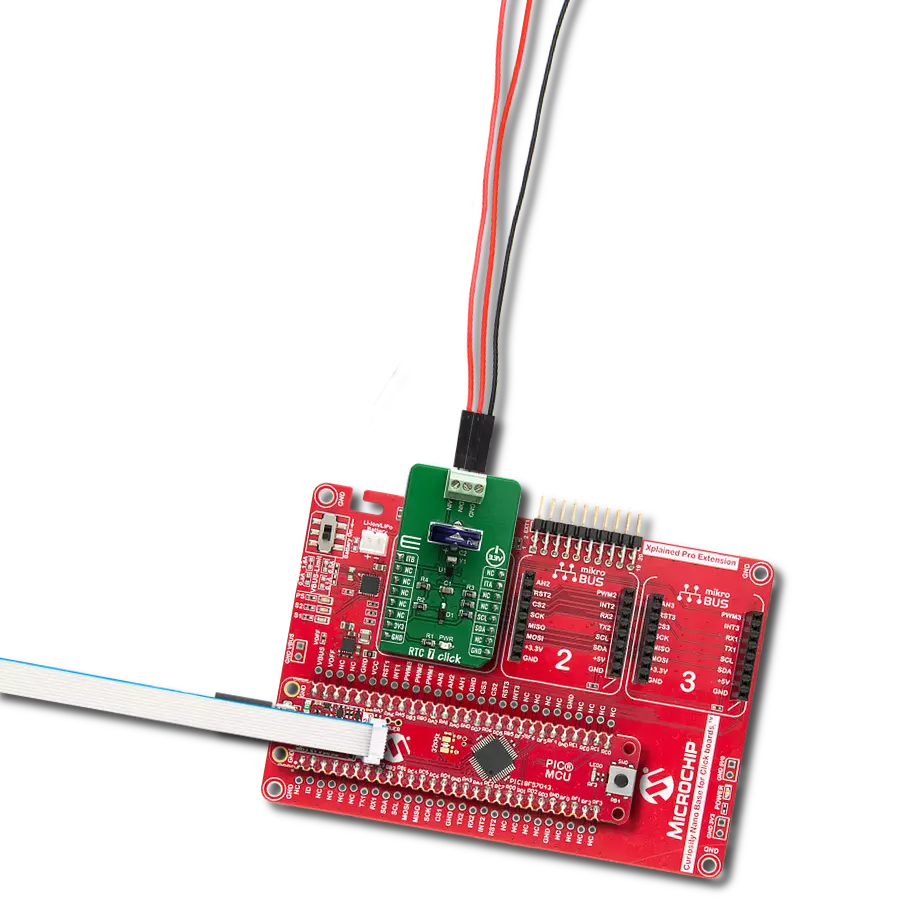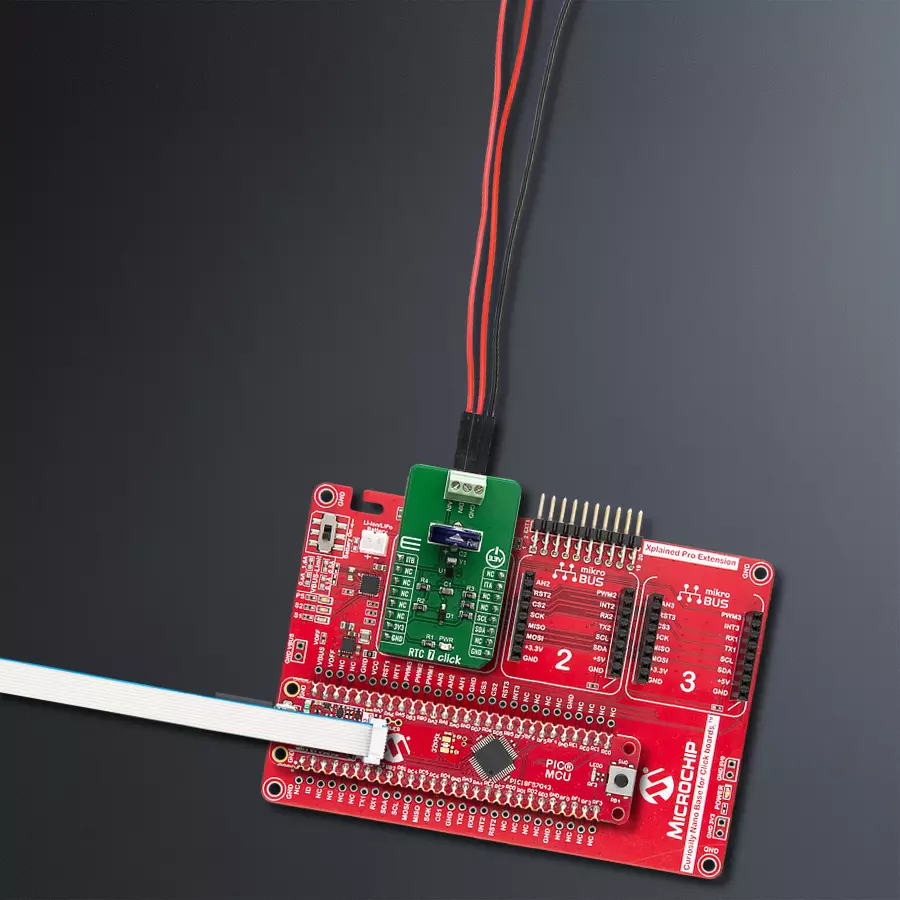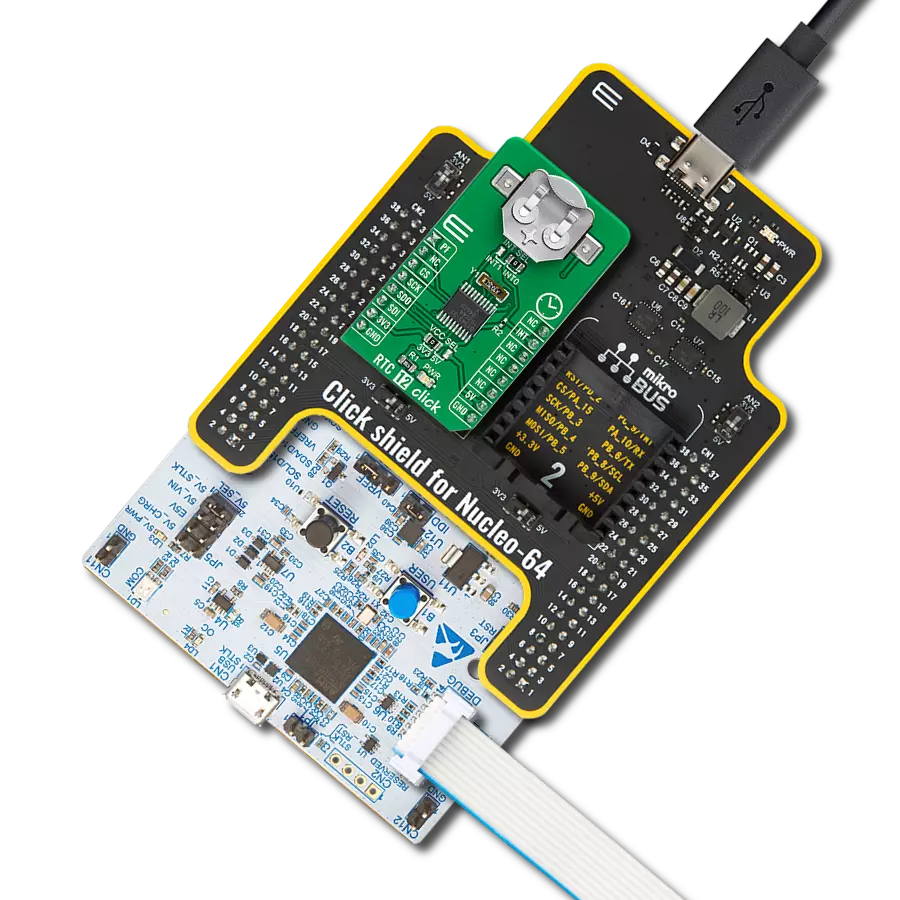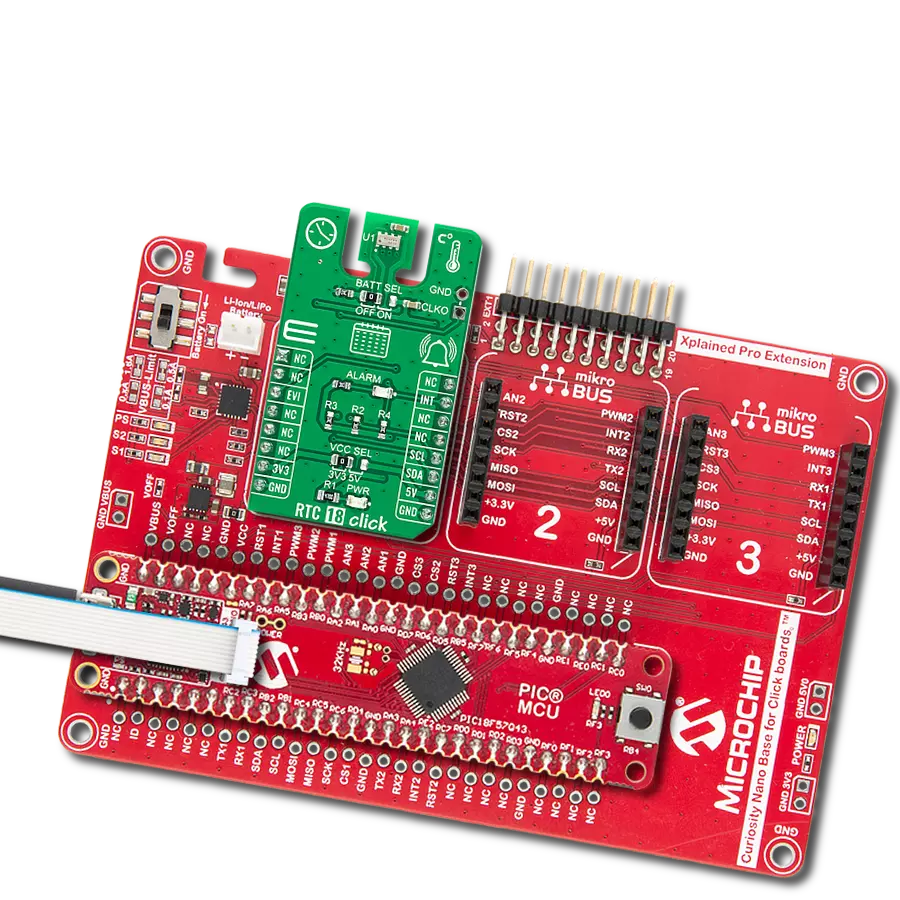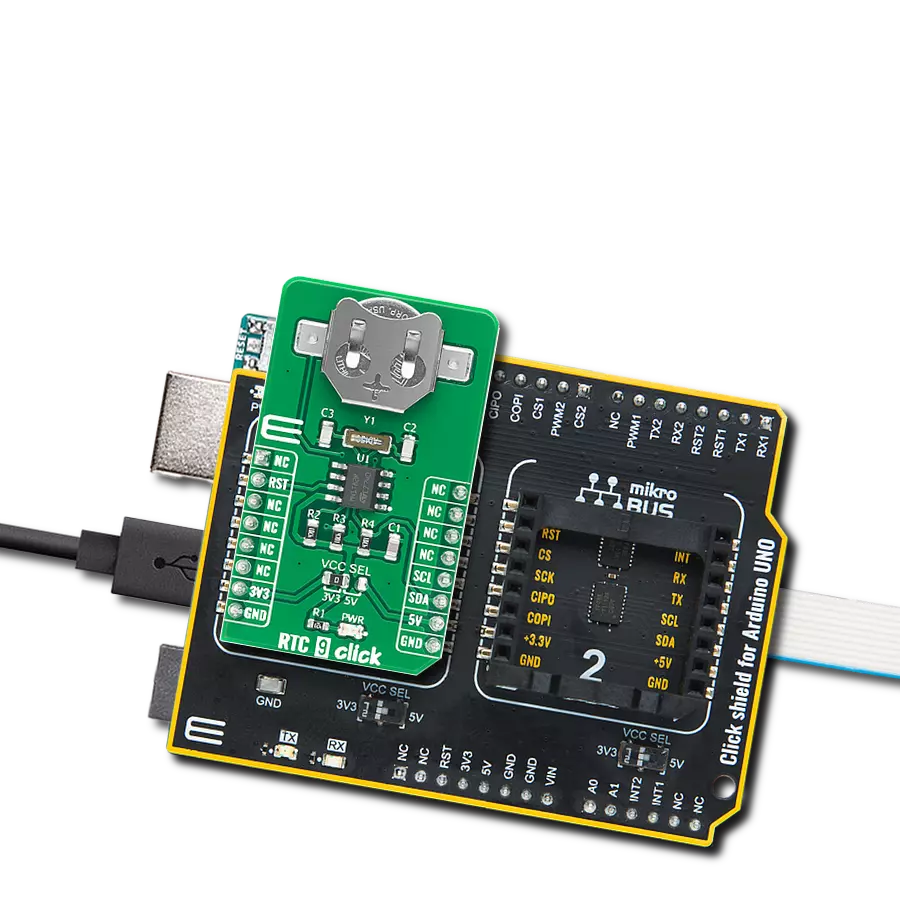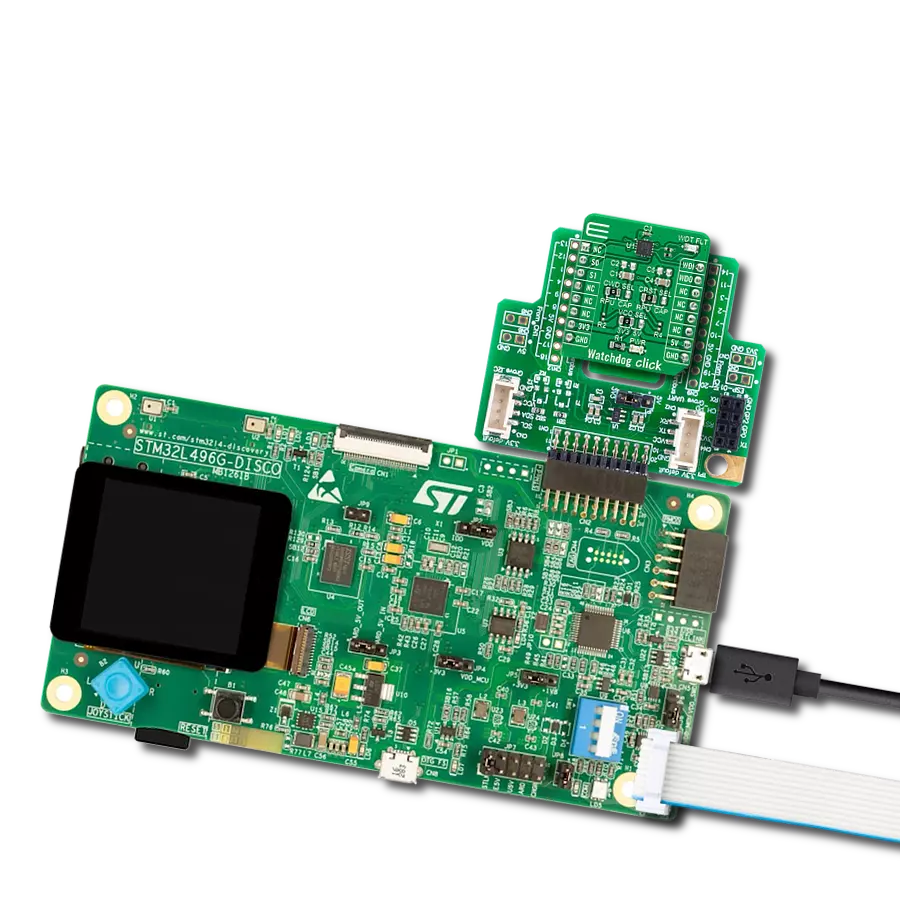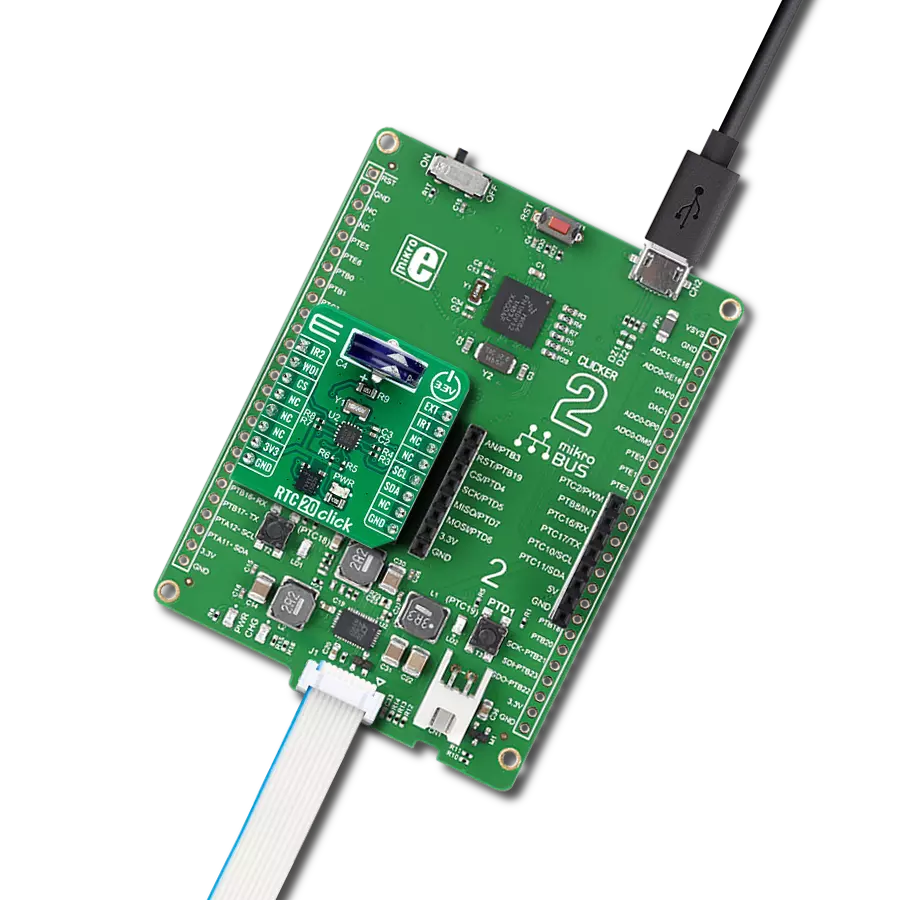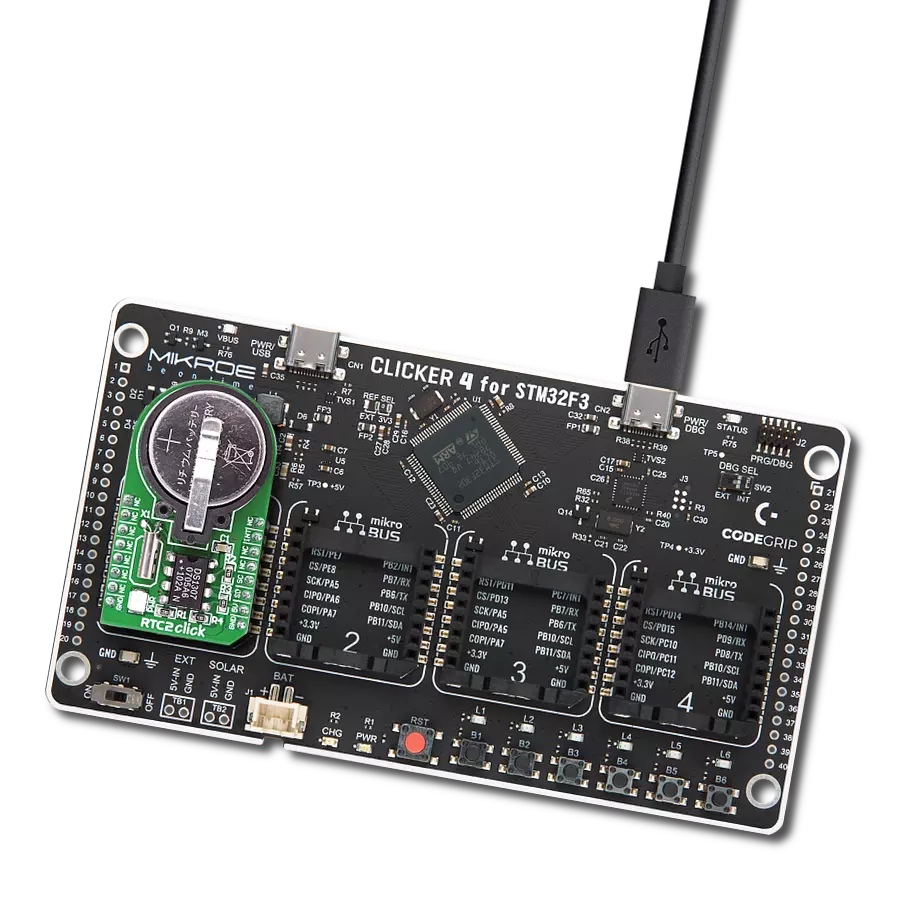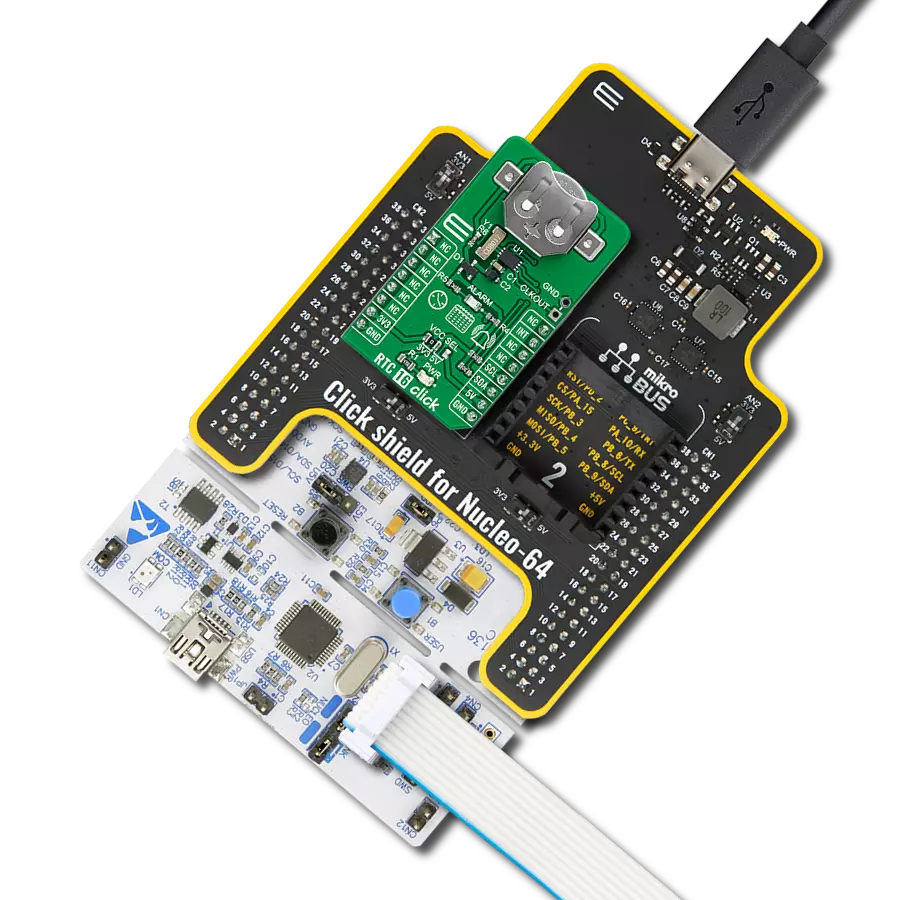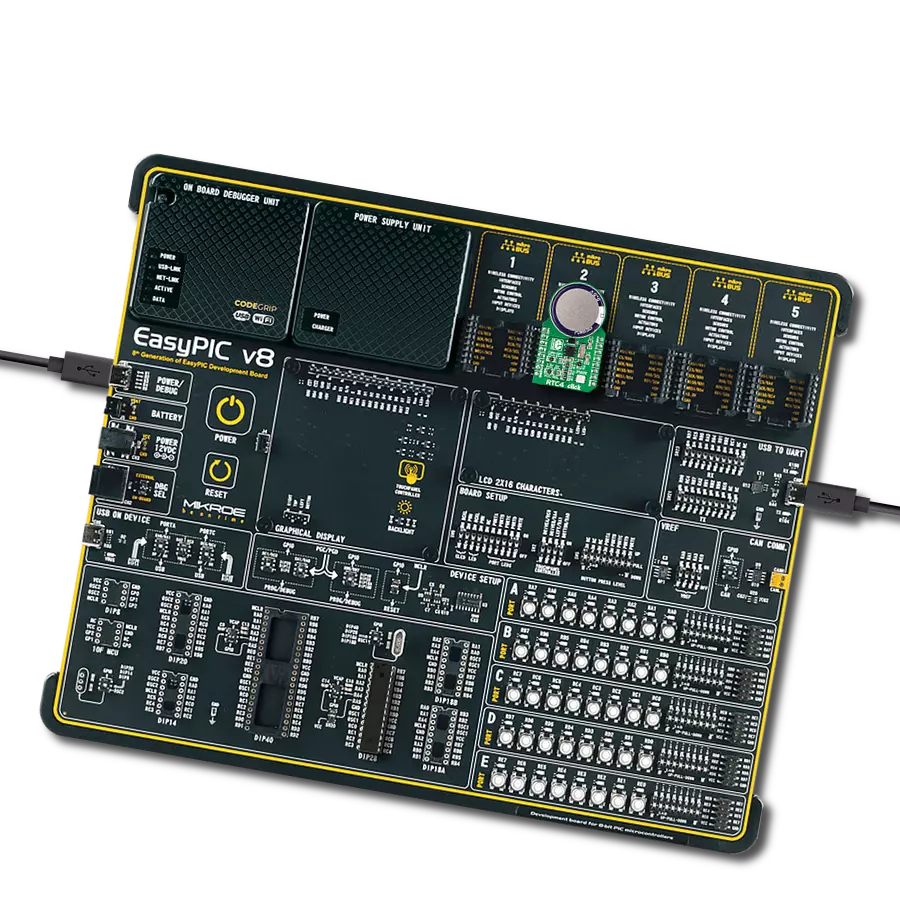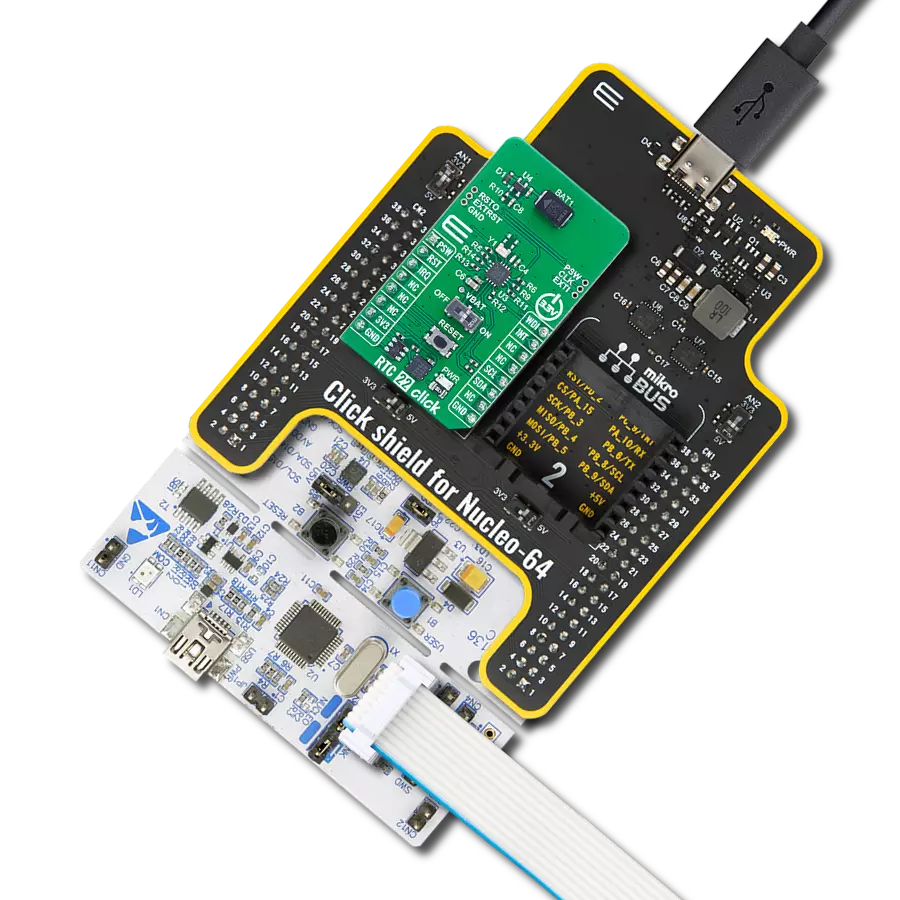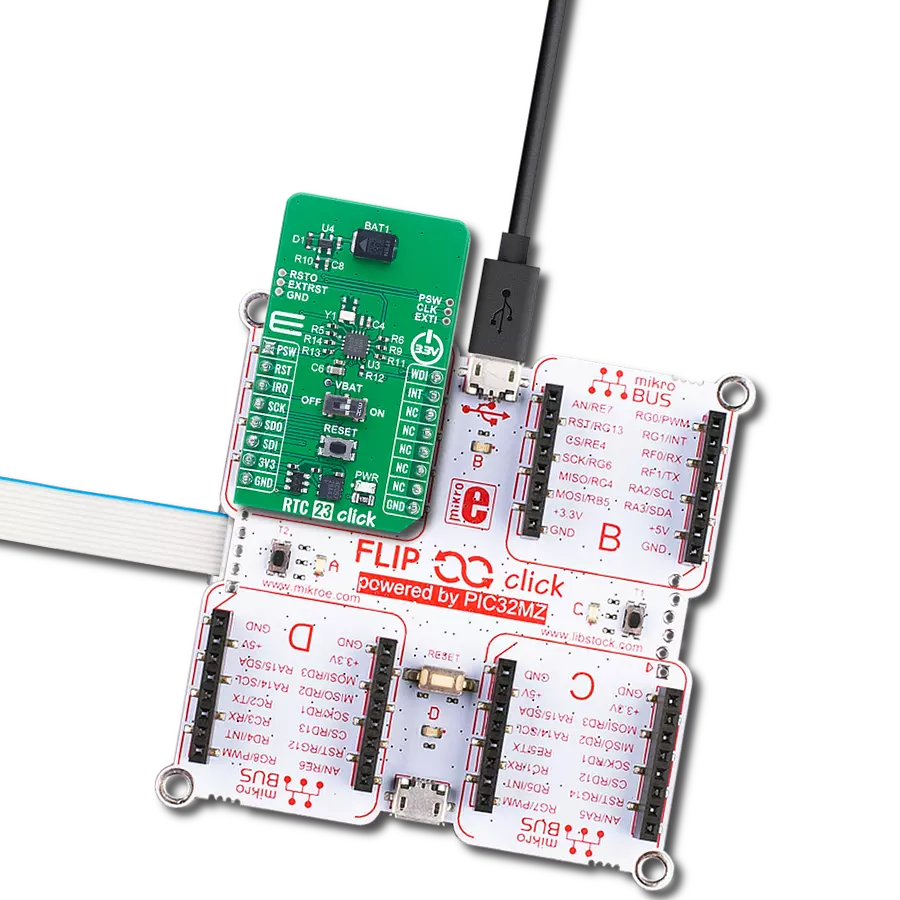Experience the power of precise timekeeping in your engineering projects by integrating state-of-the-art real-time clock solution
A
A
Hardware Overview
How does it work?
RTC 7 Click is based on the MAX31341B, a low-current Real-Time Clock with I2C interface and power management from Analog Devices. Thanks to its high integration level, this module provides high time accuracy, with a very low count of external components required. It has a full RTC function, offering programmable counters, alarms, and an interrupt engine with selectable event reporting sources. The small dimension of the MAX31341B module itself, allow it to be used in very space-constrained applications, including wearables, medical equipment, and similar. In addition to the MAX31341B, RTC 7 click is equipped with the 220mF super capacitor. By utilizing an automatic backup switch, the IC is able to use an external battery power source when there is no power supply on its main power terminals, thus allowing for uninterrupted operation. Draining as low as 180nA of current, it can be operated with the mentioned supercapacitor almost indefinitely.
In addition, a trickle charge system will replenish the super capacitor while the MAX31341B is powered over the main power terminals (VDD, VSS). The voltage of the main power supply can range between 1.6V up to 3.6V. The MAX31341B uses the I2C communication protocol for the communication with the host MCU. Besides the I2C bus lines, two additional pins are also available on the MAX31341B, INTA and INTB, allowing an interrupt to be reported to the host MCU, but also to capture an external event and marking it with an automatic timestamp. The two mentioned interrupt pins are routed to INT and AN pins of the mikroBUS™ socket, respectively. The user is able to set up standard clock and calendar functions (including seconds, minutes, hours, weekdays, date, months, years with leap year correction), as well as the interrupt functions for the periodic countdown timer, periodic time update, alarm, external event, automatic backup switchover and
power on reset (POR) events. All these features are available when the module is operated over the backup power supply (battery). Besides other functions, RTC 7 click have one analog and one digitital external input, labeled AIN and DIN. These universal inputs can be wired to any kind of external trigger, which needs to trigger one of the interrupts. The digital input can be configured to detect rising or falling edge, while the analog input, besides the edge detection, supports the programmable threshold too. For detailed information on interrupts and external triggers, refer to the MAX31341B datasheet. This Click board™ can be operated only with a 3.3V logic voltage level. The board must perform appropriate logic voltage level conversion before using MCUs with different logic levels. Also, it comes equipped with a library containing functions and an example code that can be used as a reference for further development.
Features overview
Development board
PIC18F57Q43 Curiosity Nano evaluation kit is a cutting-edge hardware platform designed to evaluate microcontrollers within the PIC18-Q43 family. Central to its design is the inclusion of the powerful PIC18F57Q43 microcontroller (MCU), offering advanced functionalities and robust performance. Key features of this evaluation kit include a yellow user LED and a responsive
mechanical user switch, providing seamless interaction and testing. The provision for a 32.768kHz crystal footprint ensures precision timing capabilities. With an onboard debugger boasting a green power and status LED, programming and debugging become intuitive and efficient. Further enhancing its utility is the Virtual serial port (CDC) and a debug GPIO channel (DGI
GPIO), offering extensive connectivity options. Powered via USB, this kit boasts an adjustable target voltage feature facilitated by the MIC5353 LDO regulator, ensuring stable operation with an output voltage ranging from 1.8V to 5.1V, with a maximum output current of 500mA, subject to ambient temperature and voltage constraints.
Microcontroller Overview
MCU Card / MCU
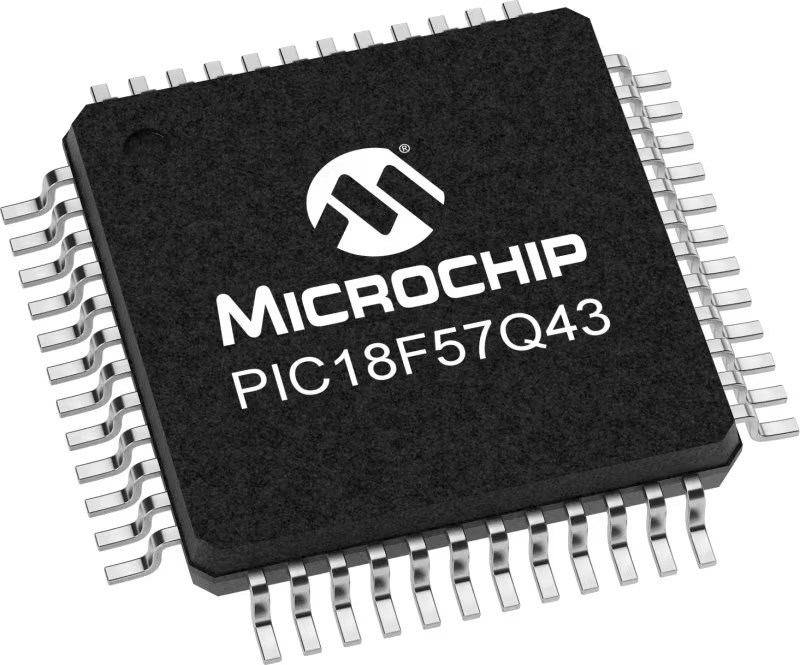
Architecture
PIC
MCU Memory (KB)
128
Silicon Vendor
Microchip
Pin count
48
RAM (Bytes)
8196
You complete me!
Accessories
Curiosity Nano Base for Click boards is a versatile hardware extension platform created to streamline the integration between Curiosity Nano kits and extension boards, tailored explicitly for the mikroBUS™-standardized Click boards and Xplained Pro extension boards. This innovative base board (shield) offers seamless connectivity and expansion possibilities, simplifying experimentation and development. Key features include USB power compatibility from the Curiosity Nano kit, alongside an alternative external power input option for enhanced flexibility. The onboard Li-Ion/LiPo charger and management circuit ensure smooth operation for battery-powered applications, simplifying usage and management. Moreover, the base incorporates a fixed 3.3V PSU dedicated to target and mikroBUS™ power rails, alongside a fixed 5.0V boost converter catering to 5V power rails of mikroBUS™ sockets, providing stable power delivery for various connected devices.
Used MCU Pins
mikroBUS™ mapper
Take a closer look
Click board™ Schematic

Step by step
Project assembly
Software Support
Library Description
This library contains API for RTC 7 Click driver.
Key functions:
rtc7_check_interrupt- This function returns the interrupt state, state of INTA pinrtc7_read_reg- This function writes one byte data to the registerrtc7_get_local_time- This function gets the local time data including the determined time zone in calculations
Open Source
Code example
The complete application code and a ready-to-use project are available through the NECTO Studio Package Manager for direct installation in the NECTO Studio. The application code can also be found on the MIKROE GitHub account.
/*!
* \file
* \brief RTC7 Click example
*
* # Description
* This app is used to accurately measure time with low power consumption.
*
* The demo application is composed of two sections :
*
* ## Application Init
* Initializes device.
*
* ## Application Task
* Waits for a second count-up interrupt and then reads and logs the current
* time and date on the USB UART.
*
* \author MikroE Team
*
*/
// ------------------------------------------------------------------- INCLUDES
#include "board.h"
#include "log.h"
#include "rtc7.h"
// ------------------------------------------------------------------ VARIABLES
static rtc7_t rtc7;
static log_t logger;
rtc7_time_t time_set;
rtc7_time_t time_date;
// ------------------------------------------------------- ADDITIONAL FUNCTIONS
void rtc7_display_results ( rtc7_t *ctx )
{
log_printf( &logger, " %.2u:%.2u:%.2u\r\n",
( uint16_t ) time_date.hours, ( uint16_t ) time_date.minutes, ( uint16_t ) time_date.seconds );
log_printf( &logger, " %.2u/%.2u/%.2u ",
( uint16_t ) time_date.monthday, ( uint16_t ) time_date.month, ( uint16_t ) time_date.year );
switch ( time_date.weekdays )
{
case 1:
{
log_printf( &logger, "MONDAY" );
break;
}
case 2:
{
log_printf( &logger, "TUESDAY" );
break;
}
case 3:
{
log_printf( &logger, "WEDNESDAY" );
break;
}
case 4:
{
log_printf( &logger, "THURSDAY" );
break;
}
case 5:
{
log_printf( &logger, "FRIDAY" );
break;
}
case 6:
{
log_printf( &logger, "SATURDAY" );
break;
}
case 7:
{
log_printf( &logger, "SUNDAY" );
break;
}
default:
{
break;
}
}
log_printf( &logger, "\r\n-------------------\r\n" );
}
// ------------------------------------------------------ APPLICATION FUNCTIONS
void application_init ( void )
{
log_cfg_t log_cfg;
rtc7_cfg_t cfg;
/**
* Logger initialization.
* Default baud rate: 115200
* Default log level: LOG_LEVEL_DEBUG
* @note If USB_UART_RX and USB_UART_TX
* are defined as HAL_PIN_NC, you will
* need to define them manually for log to work.
* See @b LOG_MAP_USB_UART macro definition for detailed explanation.
*/
LOG_MAP_USB_UART( log_cfg );
log_init( &logger, &log_cfg );
log_info( &logger, " Application Init " );
// Click initialization.
rtc7_cfg_setup( &cfg );
RTC7_MAP_MIKROBUS( cfg, MIKROBUS_1 );
rtc7_init( &rtc7, &cfg );
Delay_ms ( 300 );
time_set.seconds = 40;
time_set.minutes = 59;
time_set.hours = 23;
time_set.weekdays = 1;
time_set.monthday = 31;
time_set.month = 12;
time_set.year = 22;
err_t error_flag = rtc7_reset( &rtc7 );
error_flag |= rtc7_init_time ( &rtc7, 0 );
error_flag |= rtc7_set_gmt_time( &rtc7, &time_set );
error_flag |= rtc7_set_osc( &rtc7, RTC7_ENABLE_OSC, RTC7_INPUT_FREQ_32768HZ, RTC7_OUTPUT_FREQ_32768HZ );
error_flag |= rtc7_write_reg( &rtc7, RTC7_TIMER_INIT_REG, 15 );
error_flag |= rtc7_set_timer( &rtc7, RTC7_TIMER_EN, RTC7_TIMER_FREQ_16HZ );
Delay_ms ( 100 );
if ( RTC7_ERROR == error_flag )
{
log_error( &logger, " Default configuration." );
for ( ; ; );
}
log_info( &logger, " Application Task " );
}
void application_task ( void )
{
// Wait for timer count-down interrupt which is set to 1Hz
while ( rtc7_check_interrupt ( &rtc7 ) );
// Clear interrupt status
uint8_t int_status = 0;
rtc7_read_reg( &rtc7, RTC7_INT_STATUS_REG, &int_status, 1 );
// Read time
if ( RTC7_OK == rtc7_get_local_time( &rtc7, &time_date ) )
{
// Display time
rtc7_display_results( &rtc7 );
}
}
int main ( void )
{
/* Do not remove this line or clock might not be set correctly. */
#ifdef PREINIT_SUPPORTED
preinit();
#endif
application_init( );
for ( ; ; )
{
application_task( );
}
return 0;
}
// ------------------------------------------------------------------------ END
Additional Support
Resources
Category:RTC
